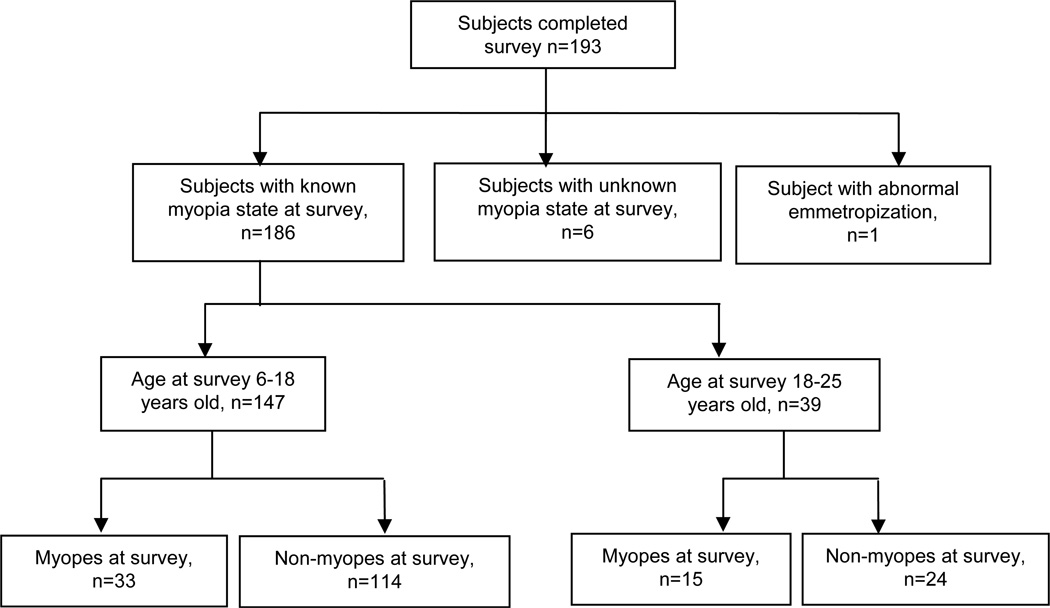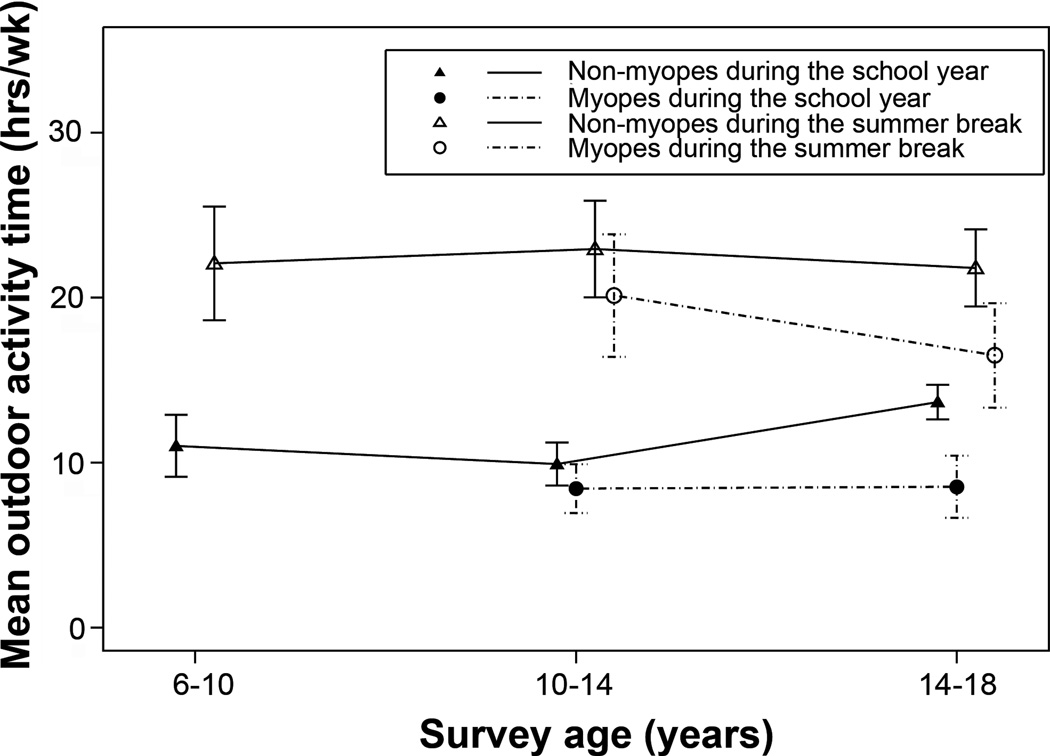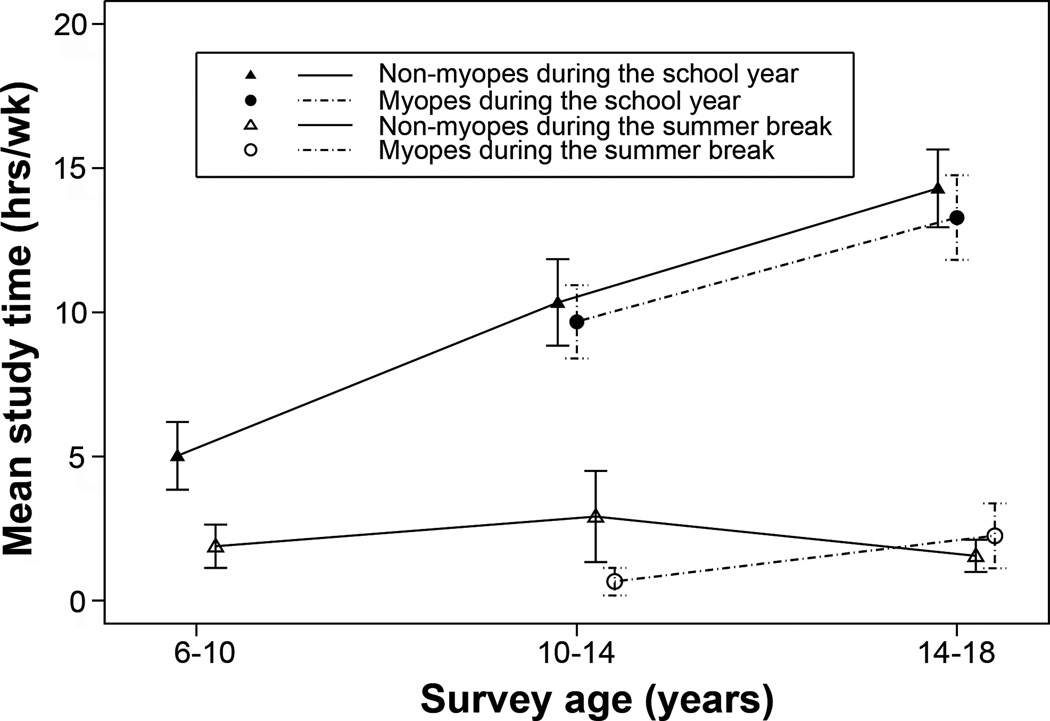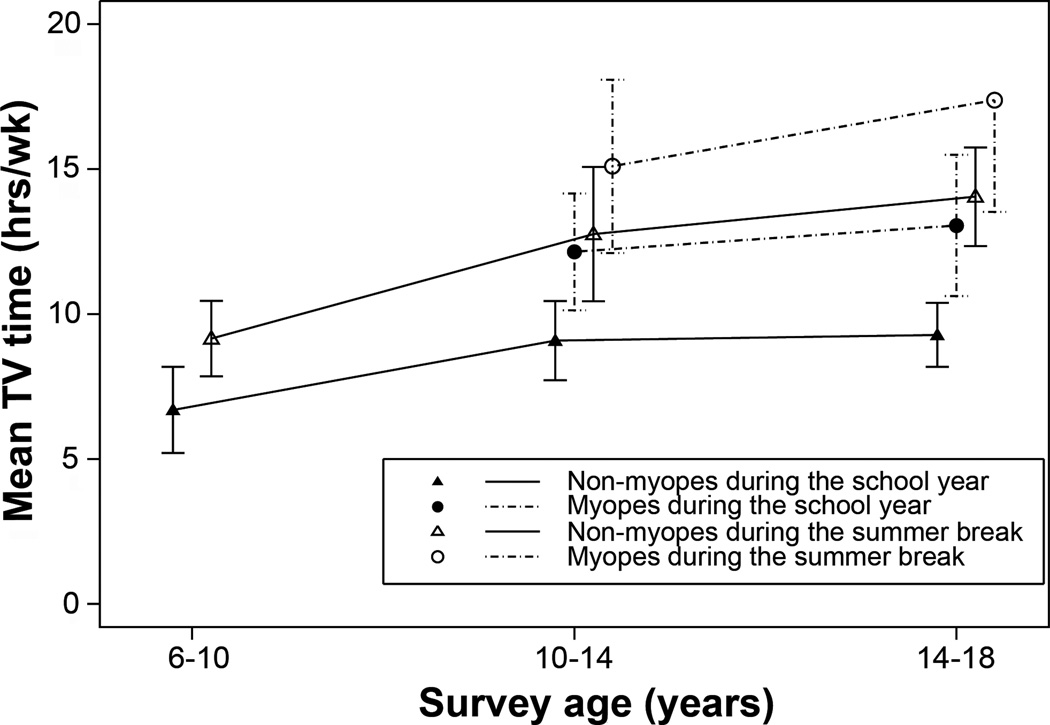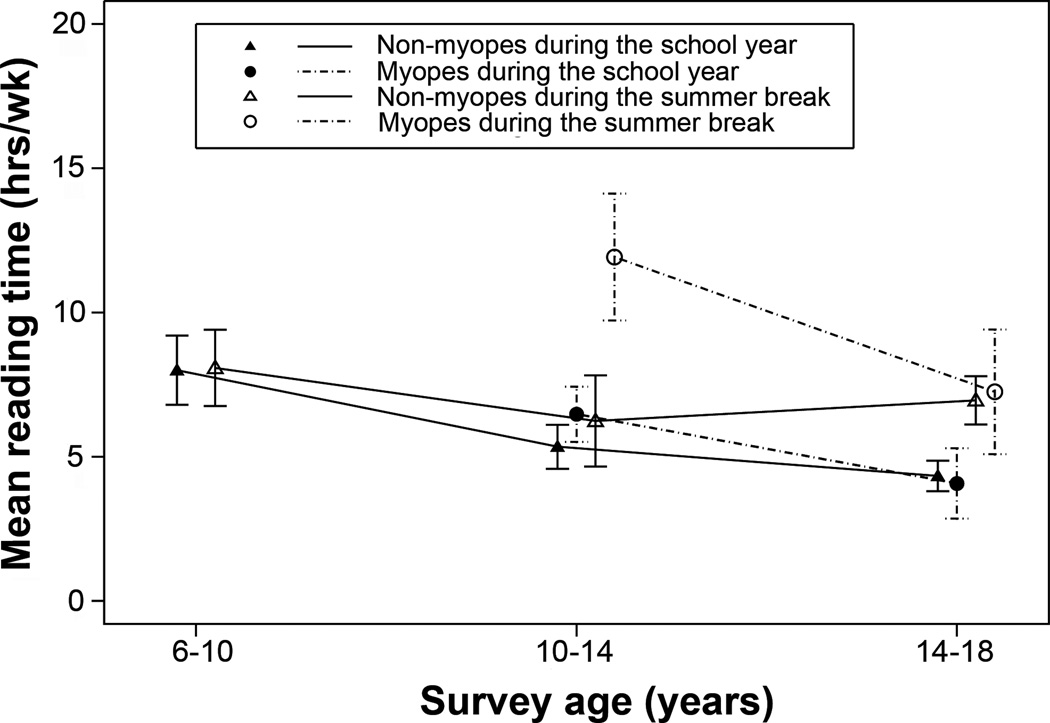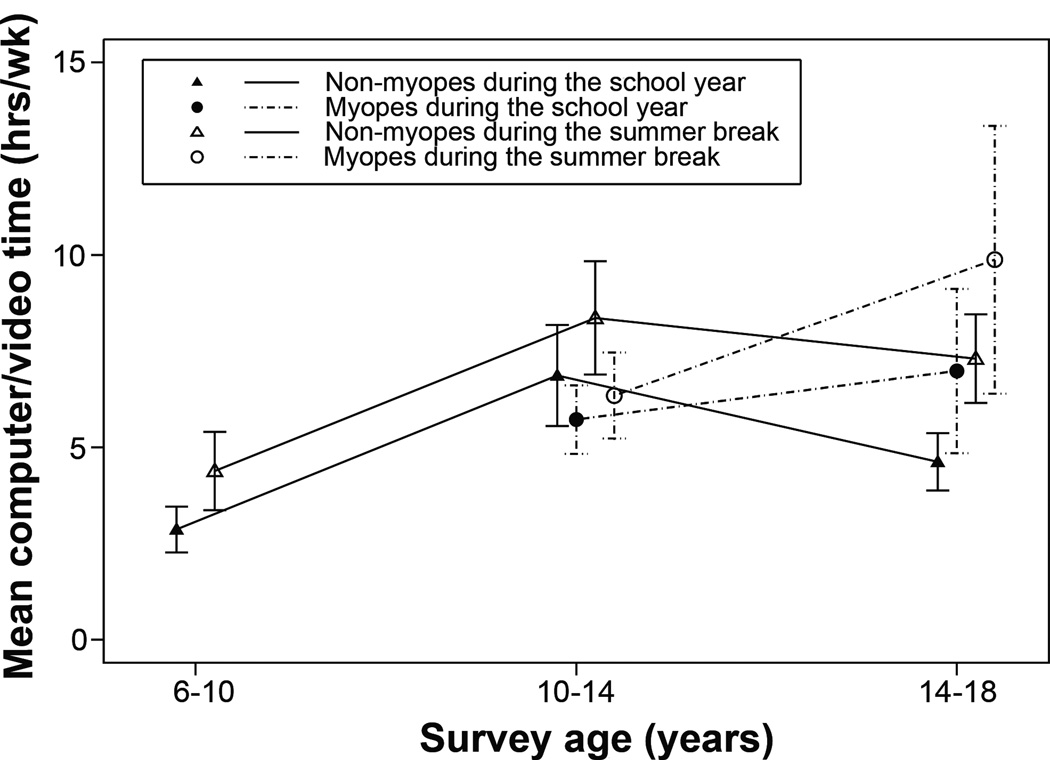Abstract
Purpose
To investigate the association of children’s refractive errors with their visual activities assessed by questionnaire in the school year and summer break (June, July and August).
Methods
The parents of 147 children aged 6–18 years participating in a longitudinal study of refraction and visual function filled out a questionnaire in 1999 listing the number of weekly hours outside of school that the children read for pleasure, studied, watched TV, used the computer/played video games, and engaged in sports/outdoor activities. They also provided hours for these activities during the summer break. Refractions were measured annually by non-cycloplegic distance retinoscopy. Myopes refer to subjects who were myopic (spherical equivalent< −0.5D) at the time of the survey and non-myopes (SER>= −0.5D) were emmetropic or in a few cases hyperopic at survey time.
Results
During the school year, myopes spent significantly fewer hours (8.25±6.25 hours/week) than non-myopes (10.95±5.95 hours/week) in sports/outdoor activity (p<0.05). In addition, myopes (12.78±9.28 hours/week) watched more television than non-myopes (8.91±5.95 hours/week) (p=0.02). No significant refractive group differences were found for other activities. During the summer break, no significant differences were found between refractive groups in any visual activity times. No significant correlations between sports/outdoor activity and TV time were found. Overall, the biggest differences between summer and school activity times were found in outdoor activity (21.76±13.80 vs.10.34±6.10 hours/week; p<0.001) and studying (1.69±3.71 vs. 9.51± 6.96 hours/week; p<0.001).
Conclusions
In agreement with other studies, the non-myopes had more hours of sports/outdoor activity during the school year, which may protect against myopia development. A new finding is the high number of sports/outdoor activity hours for both myopes and non-myopes during the summer break, which may contribute to slowed eye growth in all children during these three months.
Keywords: refractive error, myopia, children's vision, outdoor activity
Increased prevalence of myopia has been documented worldwide, especially in industrialized regions (for a review, see Morgan and Rose 20051). East Asia leads this trend, which is characterized by early onset of myopia and an increase in the prevalence of high myopia.1–3 High myopia may be associated with severe ocular complications such as glaucoma, retinal detachment or blindness and thus poses a severe public health burden.4
It is clear that the etiology of myopia is multi-factorial, with both genetic and environmental factors contributing to its development. Evidence for a genetic role includes a higher risk of developing juvenile myopia among children with myopic parents5–8 and a high positive correlation in refractive error between siblings and between parents and children.9,10
The environmental risk factor most often cited for myopia is near work, though direct evidence of an association between near work and myopia has been lacking. Much of the existing evidence is provided by epidemiological studies11–12 and by prospective studies of the onset and progression of myopia in near work-intensive academic or occupational groups.13–15 Faster myopic progression after three years of follow-up was found to be positively associated with more hours of reading.16 Assessment of near work typically has been by questionnaire, with some studies reporting a slight association between near work activities and myopia in children. Children in Singapore with more than 3 D of myopia were reported to read significantly more than the median of 2 books per week and to engage in significantly more hours of daily near work than lower myopes and non-myopes.8 A greater amount of near work had a small independent contribution to myopia in a U.S. sample of children.6 However, after six years of follow-up of the same cohort, no significant association between myopia development and near-work activities was observed.17 A longitudinal study of children in Singapore did not find a significant correlation between the annual change in refraction and the total near work hours in school.18 Regional differences have been reported, with a lower prevalence of myopia and significantly more hours of total near work activity found among Chinese children in Sydney compared to Singapore.19
A number of factors may contribute to the discrepancy in these conclusions including differences in study design, children’s ages and ethnicity, definitions of near work and myopia, and accuracy of the self-reported or parent-reported activity times. In addition, other factors such as viewing distance, lighting, and temporal factors (e.g., frequency of looking up from text and taking breaks) may be more sensitive indicators than the typically reported hours of near work.
Unlike for near work, most publications agree on a protective role of outdoor activity in myopia development as reported in questionnaires.6–7,17,20–21 In a longitudinal study in the U.S., children with more hours of sports/outdoor activity had a lower incidence of myopia than those with fewer hours.17 The Sydney myopia study reported more outdoor activity time in children with more positive refractive errors.7 Recently, myopic teenagers in Singapore were found to have significantly fewer outdoor activity hours than non-myopes.21 Only one recent study from China failed to find an association between refractive error and outdoor activity.22
In this paper we investigate hours spent on various visual activities in myopes and non-myopes during the school year and the summer break (June, July and August) using survey data from subjects who participated in a longitudinal study of refraction and visual development. A preliminary report of this work has been presented previously.23, 24
METHODS
Subjects
Parents of 193 subjects participating in a longitudinal study of visual development completed a visual activity survey conducted by the Children’s Vision Laboratory at the New England College of Optometry (NECO) in 1999 and returned their responses by mail. In addition to collecting information about time spent in various activities, the questionnaire also collected information on parental refractive status and the use of nursery lighting (reported previously25). These subjects are a subset of participants of a longitudinal study of refractive error and visual function that started in 1974 at MIT and continued at NECO until 2006. The details of subject recruitment and refraction procedures have been described elsewhere.5 Informed consent forms were signed by parents or guardians. The project was approved by Institutional Review Board at New England College of Optometry and it adhered to the tenets of the Declaration of Helsinki. Almost all subjects (95%) are Caucasian and half are females. Over 90% of the parents have a college degree or higher. They are more myopic than a general white population in the U.S., with half of the mothers and 63% of the fathers myopic.
Procedure
For the data analyzed in this paper, non-cycloplegic distance retinoscopy was used to refract the children, performed by one experienced optometrist (FT). The questionnaire asked the number of hours that children engaged in outdoor activity or sports, reading, studying, TV watching and computer use/video games per day for each weekday and weekend day during the school year and the summer vacation. Other questions included parental refraction and the age when parent(s) started to wear glasses. The raw visual activity data were converted to hours per week by adding the weekday (times 5) and weekend (times 2) hours together.
Of the 193 subjects with survey data, 186 (96%) had known refractions at the time of the survey (Figure 1). Subjects older than 18 years (n=39) were excluded since they have different life schedules from school-aged children (e.g., less outdoor activities and more study hours). Due to a high correlation (r=0.96) in refraction between the two eyes, only refractions of the right eyes were used for analyses in this paper. Myopia is defined as a spherical equivalent refraction (SER) less than −0.5D. The surveyed subjects were classified into two groups: myopes and non-myopes. Myopes refer to subjects who were myopic at the time of the survey. Non-myopes (SER>= −0.5D) refer to children who were emmetropic or in a few cases hyperopic at the time of the survey.
Figure 1.
Subject classification flow chart.
Statistical Analysis
Only data from subjects aged 18 years or younger (n=147) were included. The Spearman correlation in activity hours between school time and summer time was also calculated. The Wilcoxon signed rank test was employed to test for mean differences in activity hours between the two periods.
The remaining data analyses were done separately for the school year and the summer break. Spearman correlation coefficients were used to evaluate the associations between different types of activity. A two-way ANOVA was used to test for refractive group differences in weekly hours for each activity. Multivariate logistic regression was applied to test the association between myopia at the survey age and each activity time adjusting for survey age and the number of myopic parents. Additionally, a repeated measures ANOVA was also conducted to evaluate the effects of refractive error, age and period simultaneously on log-transformed data. Statistical significance was taken as p<0.05.
RESULTS
Of the 147 children aged 6–18 years with survey data, 33 were myopic and 114 were not. The numbers of males and females were similar. The age and gender breakdown among non-myopes and myopes is given in Table 1. The upper end points of age groups are included in the younger groups. For instance, 14 is included in the age group 10–14 and not 14–18.
Table 1.
Demographic variables of the sample.
| Count | Age (years) | Gender | All | |||
|---|---|---|---|---|---|---|
| Refractive group | 6–10 | 10–14 | 14–18 | Boys | Girls | |
| Non-myopes | 41 | 35 | 38 | 63 | 51 | 114 |
| Myopes | 3 | 16 | 14 | 17 | 16 | 33 |
| Total | 44 | 51 | 52 | 80 | 67 | 147 |
Note: The upper end points of age groups are included in the younger groups. For instance, 14 is included in the age group 10–14 but not 14–18.
During the school year, myopes spent less time on sports/outdoor activity than non-myopes, as shown in Figure 2. Overall the number of weekly outdoor activity hours in myopes (8.25±6.25) was significantly lower than non-myopes (10.95±5.95) (p<0.05). In comparison, during the summer the amount of sports/outdoor activity time was high in both refractive groups. Even though in the summer on average non-myopes spent more hours than myopes in sports or outdoors activities, the difference was not statistically significant. Results of repeated measures ANOVA showed a significant interaction between period and refractive group. Non-myopes and myopes studied similar numbers of hours per week during the school year, with increasing hours of study at older ages (p<0.0001), as shown in Figure 3. Not unexpectedly, the number of study hours in the summer break was low for all children, with a large proportion reporting no study hours. During the school year non-myopes spent fewer weekly hours watching TV than myopes, as shown in Figure 4. Overall the average weekly TV hours in non-myopes (8.91±5.95) was significantly lower than in myopes (12.78±9.28) (p<0.02). A similar pattern was found in the summer break, with slightly more hours devoted to TV viewing by both refractive groups, but there was no significant difference between refractive groups. The mean hours of reading for pleasure were significantly higher in myopes (9.39 ±8.33) than non-myopes (6.33± 5.38) only during the summer break (p = 0.02), mainly driven by the higher hours devoted to reading in the 10–14 year-old myopic group.(Figure 5). On average, there were no significant refractive group differences in computer/video time (Figure 6). The mean numbers of activity hours for all age groups combined during both the school year and the summer break are compared with other studies in discussion.
Figure 2.
Weekly outdoor activity hours during the school year and summer break by refractive error at survey time. In figures 2–6, within a given age group, activity hours are shifted to the left and right slightly to produce an easier view of mean ± standard error. The means and SE bars of myopes in the 6–10 year age group are omitted due to a very small sample size (n=3) in figures 2–6.
Figure 3.
Weekly study time outside school during the school year and summer break by refractive error at survey time.
Figure 4.
Weekly TV time during the school year and summer break by refractive error at survey time. The upper SE bar of myopes in the 14–18 year age group during the summer break is omitted.
Figure 5.
Weekly hours spent reading for pleasure during the school year and summer break by refractive error at survey time.
Figure 6.
Weekly computer/video time during the school year and summer break by refractive error at survey time.
Correlation In Activity Hours between the School Year and the Summer and Mean Activity Time in Each Period
Correlations in activity hours for the same activities performed in the summer break and the school year were higher for TV time (r=0.67), computer use (r=0.74), and reading for pleasure (r=0.76) than for studying (r=0.16) and sports/outdoor activity (r=0.34), as shown in Table 2. All correlations reached statistical significance except for study time, which was borderline significant. The two low correlations for sports/outdoor activity and studying are due in part to the large differences between school and summer hours. From the school year to the summer break, mean sports/outdoor activity hours for all subjects jumped from 10.34±6.10 hours to 21.76±13.80 hours per week. Overall more TV watching and small increases in computer/video time and reading for pleasure also were seen in the summer break, as shown in Table 2. In comparison, mean study time dropped from 9.51± 6.96 hours during the school year to 1.69±3.71 hours in the summer break. All the paired differences between the two periods are statistically significant (all p<0.001).
Table 2.
Activity hours during the school year and summer break and the correlation between the two periods.
| Weekly activity time (in hours) |
School year (mean±SD) |
Summer (mean±SD) |
p-value1 | Correlation between 2 periods |
p-value2 |
|---|---|---|---|---|---|
| Sports/outdoor activity | 10.34±6.10 | 21.76±13.80 | <0.001 | 0.34 | <0.001 |
| Study time | 9.51±6.96 | 1.69±3.71 | <0.001 | 0.16 | 0.053 |
| Reading for pleasure | 5.10±3.80 | 7.01±6.27 | <0.001 | 0.76 | <0.001 |
| TV time | 9.78±6.99 | 13.12±9.89 | <0.001 | 0.67 | <0.001 |
| Computer/video time | 5.19±4.87 | 6.82±7.07 | <0.001 | 0.74 | <0.001 |
p-value1: Significance of paired difference in activity hours between the two periods using the Wilcoxon test
p-value2: Significance of spearman correlation in activity hours between the two periods.
Correlation in Time between Activities
Correlations between times spent on any two activities were examined for myopes and non-myopes separately in both the school year and the summer break. As shown in Table 3, during the school year statistically significant positive correlations were observed for non-myopes only between TV and video game/computer time (r = 0.42) and between studying and outdoor activity (r = 0.22). A significant correlation between TV and video game/computer time was found for the non-myopes in the summer (r = 0.48). Two negative correlations approached significance (both p= 0.06) for the myopes: sports/outdoor activity and TV viewing in both the school year (r = −0.33) and the summer break (r = −0.33).
Table 3.
Spearman correlation coefficient between paired activities by refractive error and period.
| School year non-myopes n=114 | sports/outdoor | video | study | read | TV | |
| sports/outdoor | 1.000 | −0.127 | 0.221 | −0.030 | −0.027 | |
| video | 1.000 | −0.056 | 0.070 | 0.420 | ||
| study | 1.000 | −0.011 | 0.047 | |||
| read | 1.000 | −0.127 | ||||
| TV | 1.000 | |||||
| School year myopes n=33 | ||||||
| Sports/outdoor | 1.000 | −0.118 | 0.297 | −0.186 | −0.330 | |
| video | 1.000 | −0.050 | 0.219 | 0.171 | ||
| study | 1.000 | 0.111 | −0.094 | |||
| read | 1.000 | 0.003 | ||||
| TV | 1.000 | |||||
| Summer non-myopes n=114 | ||||||
| sports/outdoor | 1.000 | −0.135 | 0.090 | 0.016 | −0.108 | |
| video | 1.000 | −0.053 | −0.013 | 0.484 | ||
| study | 1.000 | 0.030 | 0.035 | |||
| read | 1.000 | −0.020 | ||||
| TV | 1.000 | |||||
| Summer myopes n=33 | ||||||
| sports/outdoor | 1.000 | −0.195 | 0.246 | 0.105 | −0.333 | |
| video | 1.000 | 0.037 | 0.148 | 0.186 | ||
| study | 1.000 | 0.250 | −0.142 | |||
| read | 1.000 | −0.133 | ||||
| TV | 1.000 | |||||
Note: correlation coefficients in bold are statistically significant at 0.05 level.
Table 4 shows the multivariate odds ratio for the association between myopia and various activities during the school year and the summer, adjusting for survey age and number of myopic parents. During the school year there were two significant activities: sports/outdoor activity had an odds ratio significantly lower than 1.0, while the odds ratio for TV viewing was significantly higher than 1.0. During the summer break, no odds ratios were statistically significant.
Table 4.
Association between myopia at survey age and activity hours adjusting for survey age and number of myopic parents.
| Activity type | OR | 95% CI |
|---|---|---|
| School year | ||
| sports/outdoor activity | 0.915 | (0.843, 0.994)† |
| TV | 1.069 | (1.010, 1.132)† |
| study | 1.018 | (0.940, 1.101) |
| video/computer | 1.028 | (0.946, 1.117) |
| reading for pleasure | 1.035 | (0.929, 1.154) |
| Summer | ||
| sports/outdoor activity | 1.000 | (0.969, 1.033) |
| TV | 1.046 | (0.999, 1.095) |
| study | 0.982 | (0.860, 1.122) |
| video/computer | 1.001 | (0.945, 1.062) |
| reading for pleasure | 1.054 | (0.989, 1.123) |
Statistically significant at 0.05 level
DISCUSSION
In this study we found two significant associations between visual activity and refractive status: (1) Myopes spent significantly fewer hours engaged in sports/outdoor activities than non-myopes during the school year but not in the summer, and (2) myopes spent significantly more hours watching TV than non-myopes during the school year but not in the summer.
Our results for sports/outdoor activity in the school year agree with previously published findings.6–7,17,20–21 The Sydney myopia study demonstrated a highly significant association between outdoor activity and the refraction of children aged 6 and 12 years.7 Likewise, a longitudinal study conducted in the U.S. reported that children spending more hours in sports/outdoor activity starting from 6 years had a reduced risk of developing myopia by the age of 13 years.17 An exploratory data analysis of outdoor activity hours using longitudinal refraction data from our laboratory showed a similar trend.
An additional finding from Jones et al.17 was that 14 or more hours of weekly sports/outdoor activities essentially negated the impact of parental myopia. However, a high amount of outdoor activity time may not be able to completely protect against the development and progression of myopia. A recent study reported an average of more than 20 hours of weekly outdoor activity among both non-myopic and myopic teenagers in Singapore, a country with a very high prevalence of myopia.21 One wonders if most of this outdoor time was during the evening after the daylight hours.
Given the limited time available for all types of visual activities in a child’s day, it is possible that the significant association between sports/outdoor activity and refractive status might reflect a trade-off between this activity and another indoor activity such as computer use or TV viewing. However, in our study there were no significant negative correlations, and only correlations between hours spent on sports/outdoor activity and TV watching approached significance and only in the myopes. It appears, therefore, that the association of sports/outdoor activity and refractive status is unlikely to be caused by the substitution of sports/outdoor activity with other activities.
The finding of a positive association between TV watching and refractive status in our study has not been found in most other studies. In the Orinda study hours spent on TV viewing were slightly higher for myopic children.6 A recent study from Taiwan reported finding a borderline significant correlation between myopia and television watching.26 As evidence for TV watching-induced myopia is lacking in the literature, further studies are needed to confirm the association reported here.
Although overall myopes spent significantly more hours than non-myopes in reading for pleasure during the summer break, this difference is mainly driven by one age group (10–14 years) and is not robust since the odds ratio associated with reading is not significantly higher than 1.
An advantage of our study is that it examined activity hours in both school and summer periods. Low correlations between the school year and the summer break for both studying and sports/outdoor activity indicate that these activities may depend on the school schedule. High numbers of summer sports/outdoor activity hours were noted for both myopes and non-myopes, suggesting that outdoor activities may slow eye growth in all children during the summer break. In agreement with this view, slowed myopia progression during the summer break27 and a positive association between more outdoor activity time and less myopic progression during the vacation period have been reported.28 Another advantage of our study is that the wide age range provides an opportunity to explore the pattern of age dependence of various activities. For instance, the monotonic increase in study time with age was clearly demonstrated in our data. The recognition of age dependence allows for a more meaningful comparison of studies with different age cohorts.
Reported visual activity times have varied by studies, as shown in Table 5. Possible sources of variability may include survey age, regional differences, ethnicity, and the design of the questionnaire. Despite these differences, most of the visual activity times reported in our study were comparable to results published previously. As seen in the table, studies conducted in Singapore and Australia had a larger range of outdoor activity hours than those conducted in the U.S. The number of hours spent in sports/outdoor activity in our study for the school year was similar to that reported for the Orinda study.6,17 The summer weekly sports/outdoor activity time in our study was close to the number given in a recent study in Singapore.21
Table 5.
Comparison of weekly activity time (mean±SD) evaluated by questionnaire across studies.
| Study | Survey age | Ethnicity | Region | Comparison Group | Outdoor | TV | Computer/ Video |
Studying | Reading for pleasure |
|---|---|---|---|---|---|---|---|---|---|
| This study school year | 6–18 years | White | Boston, MA | Myopes SER<(−0.5D) | 8.25±6.24† | 12.78±9.28 | 6.00±5.76 | 10.8±5.58 | 5.60±4.37 |
| White | Boston, MA | NonMyopes | 10.95±5.95† | 8.91±5.95 | 4.96±4.58 | 9.14±7.29 | 4.95±3.63 | ||
| This study summer | 6–18 years | White | Boston, MA | Myopes SER<(−0.5D) | 19.41±14.57† | 15.96±12.8 | 7.42±9.20 | 1.27±3.10 | 9.39±8.33 |
| White | Boston, MA | NonMyopes | 22.44±13.56† | 12.30±8.78 | 6.64±6.36 | 1.81±3.87 | 6.33±5.38 | ||
| Mutti et al. 6 | 13–14 years | Majority are white | Orinda, CA | Myopes SER <= (−0.75D) | 7.4±6.7* | 9.2±6.8 | 2.7±4.1 | 11.2±7.2 | 5.8±4.8 |
| Majority are white | Orinda, CA | Emmetropes | 9.7±6.2* | 8.3±5.7 | 2.2±3.2 | 8.9±5.2 | 4.1±4.6 | ||
| Jones et al.17 | 8–9 years | Majority are white | Orinda, CA | Future myopes SER<= (−0.75D) | 7.98±6.54† | 7.63±5.17 | 2.52±2.92 | 4.32±4.00 | 4.61±3.66 |
| Majority are white | Orinda, CA | NonMyopes | 11.65±6.97† | 8.46±5.66 | 2.45±2.81 | 4.56±3.97 | 4.06±3.48 | ||
| Dirani et al.21 | 11–20 years | Asian | Singapore | Myopes SER<= (−0.5D) | 21.63±13.44 | NA | NA | NA | NA |
| Asian | Singapore | Nonmyopes | 25.13±14.21 | NA | NA | NA | NA | ||
| Ip et al. 20 | 12–13 years | Asian | Sydney | Asian descendants | 8.5±3.35** | NA | 8±2.87** | NA | 5.9±2.39** |
| White | Sydney | European descendants | 13.5±3.83** | NA | 6.1±2.39** | NA | 4.1±2.39** | ||
| Rose et al.19 | 6–7 years | Asian | Singapore | Singapore Chinese | 3.05±0.12 | 12.65±7.37 | 3.55±4.48 | NA | NA |
| Asian | Sydney | Sydney Chinese | 13.75±1.02 | 11.32±6.47 | 4.65±6.62 | NA | NA | ||
sports activity only
sports/outdoor activities
SD was reconstructed using the CIs listed in the paper and the formula SD=width of 95% CI/(4*1.96)*sqrt(sample size).
It is not clear which aspects of outdoor activity provide a protective effect, but it appears to be related to being outdoors and not the nature of the activity. Two studies fine-tuned their questionnaire and evaluated both outdoor and indoor sports activity. Sports activity was not the key factor since indoor activity hours did not show a difference between myopes and non-myopes.7,21
Suggestions for the source of the protective effect of being outdoors include pupillary constriction, increased dopamine levels, and distance viewing. One possibility is that the contraction of the pupil in sunlight increases the depth of focus, decreases blurriness, and thus slows eye growth. More exposure to sunlight may also increase the amount of dopamine, an inhibitor of axial elongation. A third possibility focuses on distance viewing, which may provide a stop signal for eye growth.
The current study had some limitations related to the sample size and age range of the participants. Because of the relatively small number of myopes in our study, the conclusions may be more sensitive to sampling errors. The survey age range used in the analyses was broad (12 years), similar to the range in a Singapore study21 (9 years). Although statistical adjustment was made to account for the age difference at the time of the survey, the adjustment relies on the age dependence pattern observed in our sample. The conclusions could be different in other studies if the relationship between survey age and activity time differs.
In conclusion, we found more hours of sports/outdoor activity among non-myopic compared to myopic children in the school year but not in the summer break. In agreement with other studies, the non-myopes had a higher number of weekly sports/outdoor activity hours during the school year, which may protect against myopia development. A new finding is the high number of sports/outdoor activity hours for both myopes and non-myopes during the summer break, which may contribute to slowed eye growth in all children during these three months.
ACKNOWLEDGMENTS
This work was supported by NEI/NIH grants EY01191, EY014817 and EY018694. We would like to thank all participants in our longitudinal study and their families.
REFERENCES
- 1.Morgan I, Rose K. How genetic is school myopia? Prog Retin Eye Res. 2005;24:1–38. doi: 10.1016/j.preteyeres.2004.06.004. [DOI] [PubMed] [Google Scholar]
- 2.Lin LL, Shih YF, Tsai CB, Chen CJ, Lee LA, Hung PT, Hou PK. Epidemiologic study of ocular refraction among schoolchildren in Taiwan in 1995. Optom Vis Sci. 1999;76:275–281. doi: 10.1097/00006324-199905000-00013. [DOI] [PubMed] [Google Scholar]
- 3.Saw SM. A synopsis of the prevalence rates and environmental risk factors for myopia. Clin Exp Optom. 2003;86:289–294. doi: 10.1111/j.1444-0938.2003.tb03124.x. [DOI] [PubMed] [Google Scholar]
- 4.Saw SM, Gazzard G, Shih-Yen EC, Chua WH. Myopia and associated pathological complications. Ophthalmic Physiol Opt. 2005;25:381–391. doi: 10.1111/j.1475-1313.2005.00298.x. [DOI] [PubMed] [Google Scholar]
- 5.Gwiazda J, Thorn F, Bauer J, Held R. Emmetropization and the progression of manifest refraction in children followed from infancy to puberty. Clin Vis Sci. 1993;8:337–344. [Google Scholar]
- 6.Mutti DO, Mitchell GL, Moeschberger ML, Jones LA, Zadnik K. Parental myopia, near work, school achievement, and children's refractive error. Invest Ophthalmol Vis Sci. 2002;43:3633–3640. [PubMed] [Google Scholar]
- 7.Rose KA, Morgan IG, Ip J, Kifley A, Huynh S, Smith W, Mitchell P. Outdoor activity reduces the prevalence of myopia in children. Ophthalmology. 2008;115:1279–1285. doi: 10.1016/j.ophtha.2007.12.019. [DOI] [PubMed] [Google Scholar]
- 8.Saw SM, Chua WH, Hong CY, Wu HM, Chan WY, Chia KS, Stone RA, Tan D. Nearwork in early-onset myopia. Invest Ophthalmol Vis Sci. 2002;43:332–339. [PubMed] [Google Scholar]
- 9.Ashton GC. Segregation analysis of ocular refraction and myopia. Hum Hered. 1985;35:232–239. doi: 10.1159/000153551. [DOI] [PubMed] [Google Scholar]
- 10.Guggenheim JA, Pong-Wong R, Haley CS, Gazzard G, Saw SM. Correlations in refractive errors between siblings in the Singapore Cohort Study of Risk factors for Myopia. Br J Ophthalmol. 2007;91:781–784. doi: 10.1136/bjo.2006.107441. [DOI] [PMC free article] [PubMed] [Google Scholar]
- 11.Richler A, Bear JC. Refraction, nearwork and education. A population study in Newfoundland. Acta Ophthalmol (Copenh) 1980;58:468–478. doi: 10.1111/j.1755-3768.1980.tb05748.x. [DOI] [PubMed] [Google Scholar]
- 12.Zylbermann R, Landau D, Berson D. The influence of study habits on myopia in Jewish teenagers. J Pediatr Ophthalmol Strabismus. 1993;30:319–322. doi: 10.3928/0191-3913-19930901-12. [DOI] [PubMed] [Google Scholar]
- 13.Hepsen IF, Evereklioglu C, Bayramlar H. The effect of reading and near-work on the development of myopia in emmetropic boys: a prospective, controlled, three-year follow-up study. Vision Res. 2001;41:2511–2520. doi: 10.1016/s0042-6989(01)00135-3. [DOI] [PubMed] [Google Scholar]
- 14.Kinge B, Midelfart A, Jacobsen G, Rystad J. The influence of near-work on development of myopia among university students. A three-year longitudinal study among engineering students in Norway. Acta Ophthalmol Scand. 2000;78:26–29. doi: 10.1034/j.1600-0420.2000.078001026.x. [DOI] [PubMed] [Google Scholar]
- 15.McBrien NA, Adams DW. A longitudinal investigation of adult-onset and adult-progression of myopia in an occupational group. Refractive and biometric findings. Invest Ophthalmol Vis Sci. 1997;38:321–333. [PubMed] [Google Scholar]
- 16.Parssinen O, Lyyra AL. Myopia and myopic progression among schoolchildren: a three-year follow- up study. Invest Ophthalmol Vis Sci. 1993;34:2794–2802. [PubMed] [Google Scholar]
- 17.Jones LA, Sinnott LT, Mutti DO, Mitchell GL, Moeschberger ML, Zadnik K. Parental history of myopia, sports and outdoor activities, and future myopia. Invest Ophthalmol Vis Sci. 2007;48:3524–3532. doi: 10.1167/iovs.06-1118. [DOI] [PMC free article] [PubMed] [Google Scholar]
- 18.Saw SM, Nieto FJ, Katz J, Schein OD, Levy B, Chew SJ. Factors related to the progression of myopia in Singaporean children. Optom Vis Sci. 2000;77:549–554. doi: 10.1097/00006324-200010000-00009. [DOI] [PubMed] [Google Scholar]
- 19.Rose KA, Morgan IG, Smith W, Burlutsky G, Mitchell P, Saw SM. Myopia, lifestyle, and schooling in students of Chinese ethnicity in Singapore and Sydney. Arch Ophthalmol. 2008;126:527–530. doi: 10.1001/archopht.126.4.527. [DOI] [PubMed] [Google Scholar]
- 20.Ip JM, Saw SM, Rose KA, Morgan IG, Kifley A, Wang JJ, Mitchell P. Role of near work in myopia: findings in a sample of Australian school children. Invest Ophthalmol Vis Sci. 2008;49:2903–2910. doi: 10.1167/iovs.07-0804. [DOI] [PubMed] [Google Scholar]
- 21.Dirani M, Tong L, Gazzard G, Zhang X, Chia A, Young TL, Rose KA, Mitchell P, Saw SM. Outdoor activity and myopia in Singapore teenage children. Br J Ophthalmol. 2009;93:997–1000. doi: 10.1136/bjo.2008.150979. [DOI] [PubMed] [Google Scholar]
- 22.Lu B, Congdon N, Liu X, Choi K, Lam DS, Zhang M, Zheng M, Zhou Z, Li L, Sharma A, Song Y. Associations between near work, outdoor activity, and myopia among adolescent students in rural China: the Xichang Pediatric Refractive Error Study report no. 2. Arch Ophthalmol. 2009;127:769–775. doi: 10.1001/archophthalmol.2009.105. [DOI] [PubMed] [Google Scholar]
- 23.Gwiazda JE, Deng L, Thorn F. Hours spent on visual activities differ between myopic and non-myopic children. Optom Vis Sci. 2007;84 E-abstract 070044. [Google Scholar]
- 24.Gwiazda JE, Deng L, Thorn F. Hours spent on visual activities differ between myopic and non-myopic children during the school year but not the summer. Optom Vis Sci. 2009;86 E-abstract 90819. [Google Scholar]
- 25.Gwiazda J, Ong E, Held R, Thorn F. Myopia and ambient night-time lighting. Nature. 2000;404:144. doi: 10.1038/35004663. [DOI] [PubMed] [Google Scholar]
- 26.Wu PC, Yang YH. Prevalence and risk factors of myopia among school children in Chimi, Taiwan. Invest Ophthalmol Vis Sci. 2009;50 E-abstract 3951. [Google Scholar]
- 27.Fulk GW, Cyert LA, Parker DA. Seasonal variation in myopia progression and ocular elongation. Optom Vis Sci. 2002;79:46–51. doi: 10.1097/00006324-200201000-00012. [DOI] [PubMed] [Google Scholar]
- 28.Jiang BC, Schatz S, Seger K. Myopic progression and dark focus variation in optometric students during the first academic year. Clin Exp Optom. 2005;88:153–159. doi: 10.1111/j.1444-0938.2005.tb06688.x. [DOI] [PubMed] [Google Scholar]



